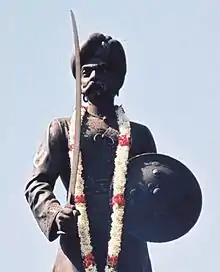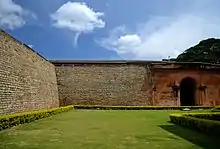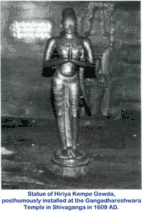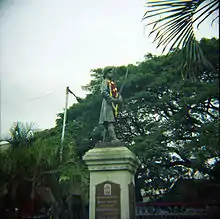Kempe Gowda I
Kempe Gowda, also known as Kempe Gowda was a chieftain under the Vijayanagara Empire.[4] The city of Bengaluru, capital of the Indian state of Karnataka, was fortified by Kempe Gowda in 1537. He erected many Kannada inscriptions in the Kannada Country.
Kempegowda | |
|---|---|
 Chief of Yalahanka Nadu (a principality under Vijayanagara Empire) | |
| Born | Hiriya Kempegowda 1510 AD |
| Died | 1569 AD |
| Resting place | Kempapura, Magadi, Ramanagara District 13.0146°N 77.08149°E |
| Other names | Bengaluru Kempe Gowda, Kempe Gowda |
| Known for | Fortifier of Bengaluru |
| Predecessor | Kempananje Gowda |
| Successor | Gidde Gowda |
| Children | Immadi Kempegowda |
| Parent(s) | Kempananje Gowda.Lingambe |
Kempe Gowda was one of the well educated and successful rulers of his time. Being a successor of Kempananje Gowda, descendants of Morasu Gowda lineage started as Yelahankanadu Prabhus (ruler of Yelhankanadu). The Yelahankanadu Prabhus were Gowdas or tillers of the land. Fourth in succession from Rana Bhairave Gowda, founder of the dynasty of Avati Nadu Prabhus and great grandson of Jaya Gowda, who established separate dynasty, is the famous Yelahanka Nadu Prabhus, Kempe Gowda I who ruled for 46 years commencing his reign from 1513. Jaya Gowda accepted the sovereignty of the Vijayanagar emperor. He later left Yelankanadu and was successful in planning and building Bengaluru Fort and Bengaluru Pete, the foundation of the current city of Bengaluru. He is also noted for his societal reforms and contribution to building temples and water reservoirs in Bengaluru. His ancestral origin is near Denkanikottai a small town in Krishnagiri District
Kempegowda's birth anniversary celebrations are organized by the state government every year across Karnataka from 27 June 2017, and is seen as Kempegowda day or ′Kempegowda Jayanthi′.[5][2][6][7][8] An award is established and named after the ruler, called Kempegowda Award, which is presented annually at ceremony held by BBMP.[9]
Early life and concept of Bengaluru
Hiriya Kempe Gowda was born in Yelahanka[3] and was the son of Kempananje Gowda, who had ruled Yelhankanadu for more than 70 years. They moved from Andra Pradesh to Karnataka in the early 1500’s. Kempe Gowda, who is reputed to have shown leadership skills during his childhood, was educated at Gurukula in Aivarukandapura (Aigondapura), a village near Hesaraghatta, for nine years.
It is said that Kempe Gowda got the vision of building a big futuristic city during a hunting expedition when he went towards Shivanasamudra (near Hesaraghatta) from Yelahanka with his Minister Veeranna and Advisor Gidde Gowda. He envisioned the city to have a fort, a cantonment, tanks (water reservoirs), temples and people of all trades and professions to live in it.[10] He conquered Sivaganga principality, 48 kilometres (30 mi) from Bangalore on Bangalore-Pune highway. Next he annexed Domlur, which is on the road from Bangalore to the old Bangalore airport. Within this vast forest area, with the necessary Imperial permission of the Vijayanagar Emperor, Achyutharaya (Dasarahalli record dated 1532) he built Bangalore Fort and the town in AD 1537, and moved his capital from Yelahanka to the new Bengaluru Pete.
Construction of Bengaluru
Kempe Gowda built a red fort with eight gates and a moat surrounding it. Inside the fort two wide roads ran from North to South and East to West. The other roads were made parallel or perpendicular to them. On an auspicious moment fixed by an astrologer, Kempe Gowda harnessed the bullocks to the ploughs at the central Doddapete square, at the junction of Doddapete (Avenue Road) and Chikka pete, got the ground ploughed and worked the four main streets running in four directions. One ran from Halasoor (Ulsoor) Gate to Sondekoppa Road from East to West, and another from Yelahanka Gate to the Fort running from North to South. These roads are the present Nagarthapete and Chikka pete; and Doddapete respectively. The streets and the Blocks were demarcated for the purpose they were meant, like for business or residences etc. Streets of Doddapete, Chikkapete, Nagartha-pete were for marketing of general merchandise; Aralepete (Cotton pet), Tharagupete, Akki pete, Ragipete, Balepete etc. were for marketing of commodities like cotton, grain, rice, ragi, and bangles respectively: kurubarapete, Kumbara-pete, Ganigarapete, Upparapete etc. were for trades and crafts, and residences of Kuruba, Kumbara, Ganiga, Uppara castes respectively and similar petes' (Blocks). Halasoorpete, Manava-rthepete, Mutyalapete (Ballapurapete) etc. were meant for other groups of the society. The Agraharas were for the priests and learned classes. He got skilled artisans and craftsmen from the neighboring as well as far off places and got them settled so that they could pursue their vocations.

Temples of Vinayaka and Anjaneya were built at the Northern Yelahanka Gate of the fort (near the present head office of State Bank of Mysore). Dodda Basavannanagudi (The Bull Temple) and in its neighbourhood, Dodda Vinayaka and Dodda Anjaneya and Veerabhadhra temples were also built outside the fort on the southern side. Gavi Gangadhareshwara temple was also built by Kempe Gowda. Kempe Gowda I encouraged the construction of temples and lakes and planned residential layouts, or agraharams, around each temple. The construction of the mud fort and several temples and lakes transformed Bangalore from a sleepy village to a centre of culture based on vedic traditions.[11]
Tanks were built for the water supply to the town, to the moat around the fort and for the irrigation of crops. Inside the fort, a big pond enclosed by masonry of dressed granite stones was dug and built (on the South-Western corner of the present Sri Krishnarajendra Market). Dhar-mambudhi tank, which supplied water to the town (present Subhash Nagar, BMTC bus stand and KSRTC bus stands, in front of the city Railway Station), Kempambudhi tank (named after Ranabhaire Gowda's family Goddess, Doddamma or Kempamma), in Gavi-pura Guttahalli and Samp-igambudhi tank (named after one of the daughters-in-law: present Sree Kanteerava Stadium), which were meant for irrigation, were also built. Irrigational facilities gave much impetus to agriculture and horticulture and also encouraged laying of gardens and raising groves of fruit crops.
The Emperor of Vijayanagara pleased with his activities bestowed him with near-by villages of Halasooru (Ulsoor), Begur, Varthur, Jigani, Thalagattapura, Kumbalgodu, Kengeri and Banavara.[12]
Social reforms and interest in art
One of his social reforms was to prohibit the custom of amputating the last two fingers of the left hand of the unmarried women during "Bandi Devaru", an important custom of Morasu Vokkaligas. He was a patron of art and learning.
Later life and legacy

In the mid 16th century due to a complaint from neighbouring Palegar, Jagadevaraya of Channapattanathe, Emperor Sadashivaraya of Vijayanagara Empire under the supervision of Aliya Ramaraya, imprisoned Kempe Gowda for minting his own coins without the Emperor's prior approval and for fear of rise in power at Penukonda. His territories were also confiscated. He was later released after being imprisoned for five years. After being released, he was awarded back his territories.[13]
He died in 1569, having ruled for about 56 years. A metal statue of Kempe Gowda was posthumously installed in 1609 at Gangadhareshwara temple at Shivagange. In 1964, another statue was erected in front of the Corporation Office, Bangalore. According to some literary sources, Bengaluru Kempe Gowda's elder son Gidde Gowda, took over control after his death.[14]


On 14 December 2013, Bengaluru's main international airport was renamed as Kempegowda International Airport.[15][16]
Bengaluru's prominent Kempegowda Bus Station has been named[17] so to honour Kempegowda. The Bangalore Development Authority developed the Nadaprabhu Kempegowda Layout.[18][19] The prominent Majestic metro station on the Purple Line (Namma Metro) of Bengaluru's Namma Metro has been renamed in Kempegowda's honour.[1]
Educational institutions such as the Kempegowda Institute of Medical Sciences, Kempegowda Institute of Physiotherapy,[20] Kempegowda College of Nursing,[21] and the Kempegowda Residential PU College have been named after Kempegowda. A locality[22] and a park[23] in Bengaluru are named in Kempegowda's honour. A busy[24] thoroughfare in Bengaluru has been named as the Kempegowda Road.[25] The Nadaprabhu Kempegowda Convention Center is located in Bengaluru.[26][27]
On 27 June 2020 commemorating the 511th birth anniversary of Kempe Gowda, work on a 108-feet tall Kempegowda Statue and a 23-acre Central park around the statue formally began on with Chief Minister B. S. Yediyurappa performing a Bhoomi Pooja at the Kempegowda International Airport.[28]
Lineage
The lineage of Kempe Gowda lasted for a century in Magadi, where they built many temples, forts and tanks. Nelapattana, a subterranean town was built on the foot of the Savandurga, to protect themselves from Muslim invasions. However, in 1728, the Dalawayis of Mysore Kingdom defeated Kempe Gowda and annexed the principality. The last ruler was imprisoned in Srirangapatana till his death. The family members were moved to Hulikal village in Magadi, where the lineage continues to survive. Some other family members were pensioned off by Dewan Purnaiah by granting jagirs in Hosur, present day Tamil Nadu, where the lineage continues to exist as farmers.[29][30]
Tomb of Kempegowda
The inscription of 16th century in Kannada on the tomb proclaims that Hiriya Kempegowda had died at the spot while returning from Kunigal. Reportedly after settling a dispute, Kempagowda was returning to Bengaluru from Kunigal. On 7 March 2015 the tomb was accidentally found by Prashanth Marur, a college official turned historian while he was driving by Kempapura village in Magadi. It was also authenticated by group of historians who visited the tomb. It is believed that Immadi Kempegowda, son of Kempegowda I, built the tomb when his father died.[31] After the confirmation Prashanth Marur wrote an article and published in Vijayavani newspaper on September 3, 2015..
References
- "Namma Metro's bane now lies in a name".
- "Nada Prabhu Jayanthi this year, every year: Siddaramaiah". 27 June 2017.
- vinod2407 (3 September 2012). "Yelahanka – Birth Place of KempeGowda". yelahankaupdate. Retrieved 25 January 2017.
- Tagliacozzo, Eric (5 January 2015). Asia Inside Out. Harvard University Press. p. 363. ISBN 978-0-674-96694-9.
- "Nadaprabhu Kempegowda Jayanti in city tomorrow - Star of Mysore". 26 June 2017.
- "Kempegowda Jayanti in city - Star of Mysore". 27 June 2017.
- "Govt. to celebrate Kempegowda Jayanti on June 27". 25 June 2017 – via www.thehindu.com.
- "Kempegowda Jayanthi 2017: Kempegowda was a secular man, says D K Shivakumar". 27 June 2017.
- "Kempegowda awards presented". thehindu.com. Retrieved 14 May 2017.
- "Vokkaligara Parishat of America (VPA) - About Vokkaligas". www.myvpa.org. Retrieved 25 January 2017.
- "CHAPTER 5: BANGALORE: MUD FORT TO SPRAWLING METROPOLIS" (PDF).
- Dr. Suryanath U. Kamat (2001). Concise History of Karnataka, MCC, Bengaluru (Reprinted 2002).
- "Kempe Gowda| Founder of Bangalore | Personalities". Karnataka.com. 11 November 2011. Retrieved 25 January 2017.
- Nilakanta Sastri, K.A. (1935). The CōĻas, University of Madras, Madras (Reprinted 1984).
- "Bangalore Intl' airport being renamed as Kempegowda International Airport - Firstpost". www.firstpost.com.
- "Bangalore International Airport Ltd will be Kempegowda International Airport from December 14". 24 November 2013 – via The Economic Times.
- "From Dharmambudhi Lake to Majestic - a less known metamorphose - KannadaGottilla.com". kannadagottilla.com.
- Bharadwaj, K. V. Aditya (27 July 2015). "Sites in Kempegowda Layout still a pipe dream" – via www.thehindu.com.
- "Dropping out of site".
- "Kempegowda Institute Of Physiotherapy". Kimsphysiotherapy.org. Retrieved 17 July 2018.
- "kimsnursing.org Is For Sale". www.kimsnursing.org.
- Gowhar, Imran (15 March 2015). "27 posts lying vacant in Kempegowda Nagar police station" – via www.thehindu.com.
- "Nadaprabhu Kempegowda Park, K R Road Visveswarapuram, Kalasipalyam, Bangalore | Parks | Video Driving Directions | Route Map | Location Map". VIDTEQ. Retrieved 17 July 2018.
- "Road over Metro tunnel sinks 15 feet". 3 August 2016.
- Staff Reporter (2 August 2016). "Portion of K.G. Road caves in near Metro line" – via www.thehindu.com.
- "Royal Kempegowda Convention Hall - convention halls in yelahanka".
- "Anubhandana". www.nkccbangalore.com.
- "KARNATAKA CM BSY TO PERFORM BHOOMI POOJA FOR KEMPEGOWDA STATUE AT BENGALURU AIRPORT". Bangalore Mirror.
- Swamy, S Narayana (8 October 2013). "Founding fathers of Bengaluru" (Bangalore). Deccan Herald. Retrieved 2 February 2015.
- Rice, Benjamin Lewis (1887). Mysore: A Gazetteer Compiled for Government. London, UK: Asian Educational Services. p. 70. ISBN 8120609778. Retrieved 17 January 2015.
- FPJ, Bureau. "Historians find tomb of Kempegowda". www.freepressjournal.in. Retrieved 25 January 2017.
Further reading
- Puttaswamy, B. S. Yalahanka Nadaprabhu Kempegowda Mattu Atana Vamshastaru,(In Kannada) 240 pp. Bengaluru: Manoj Publications, 2011. ISBN 978-81-920681-0-7
External links
| Wikimedia Commons has media related to Kempe Gowda. |
- City founder Kempegowda's tomb is traced to Magadi; bangaloremirror.com